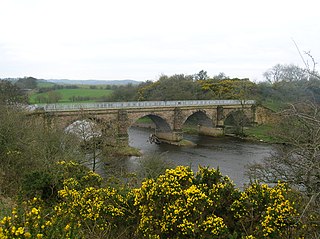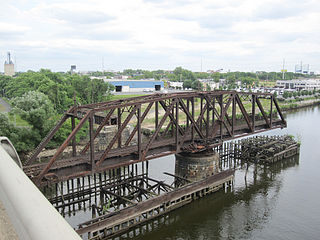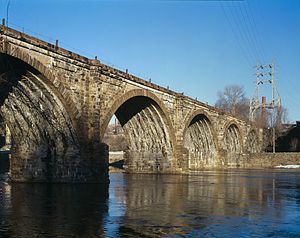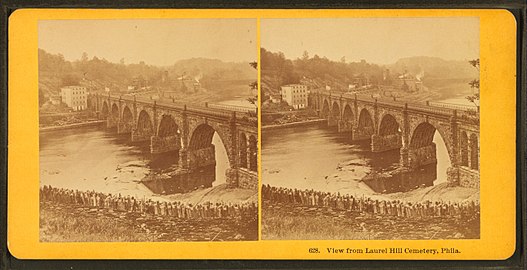
A viaduct is a specific type of bridge that consists of a series of arches, piers or columns supporting a long elevated railway or road. Typically a viaduct connects two points of roughly equal elevation, allowing direct overpass across a wide valley, road, river, or other low-lying terrain features and obstacles. The term viaduct is derived from the Latin via meaning "road", and ducere meaning "to lead". It is a 19th-century derivation from an analogy with ancient Roman aqueducts. Like the Roman aqueducts, many early viaducts comprised a series of arches of roughly equal length.

The Schuylkill River is a river running northwest to southeast in eastern Pennsylvania, which was improved by navigations into the Schuylkill Canal. Several of its tributaries drain major parts of the center-southern and easternmost Coal Regions in the state. It flows for 135 miles (217 km) from Pottsville to Philadelphia, where it joins the Delaware River as one of its largest tributaries.
The Schuylkill Expressway, locally known as "the Schuylkill", is a two to eight lane freeway through southwestern Montgomery County and the city of Philadelphia in Philadelphia County, and the easternmost segment of Interstate 76 (I-76) in the U.S. state of Pennsylvania. It extends from the Valley Forge exit of the Pennsylvania Turnpike in King of Prussia, paralleling its namesake Schuylkill River for most of the route, southeast to the Walt Whitman Bridge over the Delaware River in South Philadelphia. It serves as the primary corridor into Philadelphia from points west. Maintenance and planning are administered through Pennsylvania Department of Transportation (PennDOT) District 6, with the Delaware River Port Authority (DRPA) maintaining the approach to the Walt Whitman Bridge.

The Schuylkill River Trail is a multi-use trail along the banks of the Schuylkill River in southeastern Pennsylvania. Partially complete as of 2018, the trail is ultimately planned to run about 140 miles (230 km) from the river's headwaters in Schuylkill County to Fort Mifflin in Philadelphia.

Windsor Railway Bridge is a wrought iron 'bow and string' bridge in Windsor, Berkshire, crossing the River Thames on the reach between Romney Lock and Boveney Lock. It carries the branch line between Slough and Windsor.

The West Philadelphia Elevated, also known as the High Line or Philadelphia High Line, is a railroad viaduct in the western part of Philadelphia, Pennsylvania. The 8,140-foot (2,480 m) structure spans the railway lines of 30th Street Station, parallel to the main track of the station, in a north-south direction. The 1,045-foot (319 m) long approach made of brick arches is the longest brick bridge and probably even the longest brick building in the United States.

The Falls Bridge is a steel Pratt truss bridge that spans the Schuylkill River in Fairmount Park in Philadelphia, Pennsylvania. It connects Kelly Drive at Calumet Street with Martin Luther King, Jr. Drive at Neill Drive. It replaced a wooden covered bridge at the same site.

A skew arch is a method of construction that enables an arch bridge to span an obstacle at some angle other than a right angle. This results in the faces of the arch not being perpendicular to its abutments and its plan view being a parallelogram, rather than the rectangle that is the plan view of a regular, or "square" arch.

Gray's Ferry Bridge has been the formal or informal name of several floating bridges and four permanent ones that have carried highway and rail traffic over the Schuylkill River in Philadelphia. The bridge today is a four-lane divided highway bridge, built in 1976, that carries Grays Ferry Avenue from the Grays Ferry neighborhood on the east bank, over the river and the Northeast Corridor railroad tracks, to the Southwest Philadelphia neighborhood of Kingsessing.

Hereford Road Skew Bridge is a disused railway bridge in Ledbury, Herefordshire. Built in 1881 to carry the Ledbury and Gloucester Railway across the Hereford Road at an angle of approximately 45°, it was built as a ribbed skew arch with stone spandrels and wing walls, and ribs of blue brick. The railway line was closed in 1959 and the bridge is now used as part of the Ledbury Town Trail footpath.

Spring Garden Street Bridge is a highway bridge in Philadelphia, Pennsylvania, USA, that crosses the Schuylkill River below Fairmount Dam. It connects West Philadelphia to the Philadelphia Museum of Art and Benjamin Franklin Parkway. It is the fourth bridge at this location.

The Manayunk Bridge is an S-shaped former railroad bridge over the Schuylkill River, Schuylkill Canal and Schuylkill Expressway, that connects Bala Cynwyd, Montgomery County and the Manayunk neighborhood of Philadelphia, Pennsylvania. Closed to rail traffic in 1986, it is now an extension of the Cynwyd Heritage Trail and connects to the Schuylkill River Trail.

The Girard Avenue Bridge is an automobile and trolley bridge in Philadelphia, Pennsylvania, that carries Girard Avenue over the Schuylkill River. It connects the east and west sections of Fairmount Park, and the Brewerytown neighborhood with the Philadelphia Zoo. The current bridge is the third built on the site.

Pennsylvania Railroad, Connecting Railway Bridge is a stone arch bridge in Philadelphia, Pennsylvania, that carries Amtrak Northeast Corridor rail lines and SEPTA and NJT commuter rail lines over the Schuylkill River. It is located in Fairmount Park, just upstream from the Girard Avenue Bridge.
Spider Bridge at Falls of Schuylkill was an iron-wire footbridge erected in 1816 over the Schuylkill River, north of Philadelphia, Pennsylvania. Though a modest and temporary structure, it is thought to have been the first wire-cable suspension bridge in the world.

The Twin Bridges are a pair of steel-plate girder bridges that span the Schuylkill River in Fairmount Park in Philadelphia, Pennsylvania. They carry northbound and southbound traffic on US 1 just north of its intersection with Interstate 76.

Chain Bridge at Falls of Schuylkill was an 1808 iron-chain suspension bridge built across the Schuylkill River, north of Philadelphia, Pennsylvania. Designed by inventor James Finley, it became the model for his later chain suspension bridges. It collapsed in 1816 under a heavy load of snow.

The Philadelphia and Reading Railroad, Bridge at West Falls is a stone and iron plate girder bridge in Philadelphia, Pennsylvania that carries two CSX Trenton Subdivision tracks over Kelly Drive, Schuylkill River, and Martin Luther King Jr. Drive.

Columbia Railroad Bridge, also known as "Columbia Bridge", is a 1920 concrete arch bridge in Philadelphia, Pennsylvania, that carries CSX Trenton Subdivision rail lines over the Schuylkill River. Located in Fairmount Park, upstream of the Pennsylvania Railroad Connecting Bridge, it is the third railroad bridge at the site. Near its east abutment are the Schuylkill Grandstand and the John B. Kelly statue.

Philadelphia, Wilmington and Baltimore Railroad Bridge No. 1 was a swing steel through truss that spanned the Schuylkill River between Philadelphia, Pennsylvania's Kingsessing and Grays Ferry neighborhoods.























